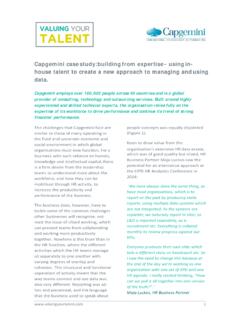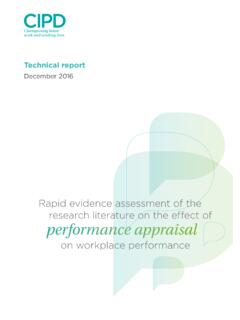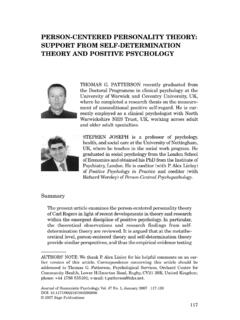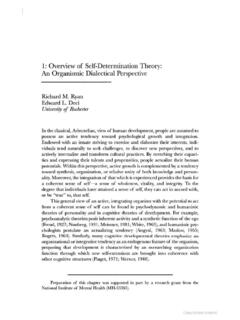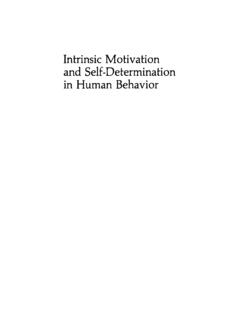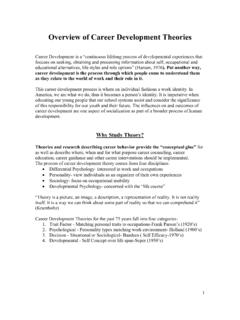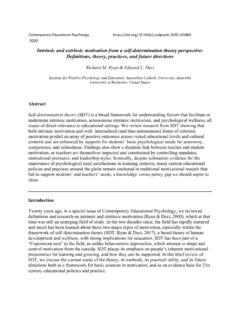Transcription of Work motivation: an evidence review
1 Scientific summary January 2021An evidence review work MOTIVATIONThe CIPD is the professional body for HR and people development. The registered charity champions better work and working lives and has been setting the benchmark for excellence in people and organisation development for more than 100 years. It has more than 150,000 members across the world, provides thought leadership through independent research on the world of work , and offers professional training and accreditation for those working in HR and learning and development. 1 work motivation : an evidence review Contents 1 Rationale for this review .. 2 2 Main question: What will the review answer? .. 2 3 Search strategy: How were the research papers obtained? .. 2 4 Selection: How were the research papers selected? .. 3 5 Main findings .. 3 6 Limitations .. 13 References .. 13 Appendix 1: Search terms and results .. 17 Appendix 2: Study selection .. 18 Appendix 3: Measures of motivation .
2 20 Acknowledgements This report was written by Emilia Wietrak, Denise Rousseau and Eric Barends at the Center for evidence -Based Management (CEBMa). Publication information When citing this report, please use the following citation: Wietrak, E., Rousseau, D. and Barends, E. (2021) work motivation : an evidence review . Scientific summary. London: Chartered Institute of Personnel and Development. 2 1 Rationale for this review It is widely assumed that employees who are highly motivated will not only be happier, healthier and more fulfilled, but also more likely to deliver better performance, services, and innovation. This assumption lies at the heart of what is often referred to as employee engagement , a concept that s become mainstream in management thinking over the last decade. Although this assumption appears to make sense from a managerial perspective, it is yet unclear whether it is supported (or contradicted) by scientific evidence .
3 For this reason, the Chartered Institute of Personnel and Development (CIPD) approached the Center for evidence -Based Management (CEBMa) to undertake a review of the research literature to learn more about the evidence on work motivation . We have completed a review of the relevant scientific literature and summarise the findings. This report describes how we undertook the review and summarises the findings. It accompanies three other reviews of the scientific literature on: performance outcomes of employee engagement antecedents and outcomes of organisational commitment antecedents and outcomes of organisational identification. These scientific summaries and a discussion report are all available at: 2 Main question: What will the review answer? What is known in the scientific literature about work motivation ? Sub-questions that form the basis of the review : 1 What is work motivation ? 2 How and when are employees motivated to perform a certain task?
4 3 How can work motivation be measured? 4 What factors are known to drive work motivation ? 3 Search strategy: How were the research papers obtained? To answer the review questions, the following databases were used to identify social theories that provide a logic model for the effect of work motivation : ABI/INFORM Global from ProQuest, Business Source Premier from EBSCO, PsycINFO from Ovid, and Google Scholar. In addition, 23 previous REAs conducted by CEBMa were screened to find additional relevant motivational theories and antecedents. Next, an additional search was conducted to identify meta-analyses and longitudinal studies that may provide additional and/or new insights into the topic of work motivation . For this additional search, the following general search filters were applied: 1 scholarly journals, peer-reviewed 2 published in the period 2000 to 2020 3 articles in English. We conducted three different search queries which yielded 218 papers.
5 An overview of all search terms and queries is provided in Appendix 1. 3 4 Selection: How were the research papers selected? Selection took place in two phases. First, titles and abstracts of the papers identified were screened for relevance. In case of doubt or lack of information, the paper was included. Second, papers were selected based on the full text. This second phase yielded a total number of 13 literature reviews, 48 meta-analyses, and 13 primary studies. An overview of the selection process is provided in Appendix 2. 5 Main findings Question 1: What is work motivation ? The general term motivation is a rather abstract construct for which numerous definitions are available, such as: the reason why somebody does something or behaves in a particular way (Oxford Dictionary) a reason for doing a particular activity or behaving in a particular way (Oxford Learner s Dictionary of Academic English) the need or reason for doing something (Cambridge Dictionary).
6 In the realm of work and business, however, definitions are more specific: internal and external factors that stimulate desire and energy in people to be continually interested and committed to a job, role or subject, or to make an effort to attain a goal (online Business Directory) a set of energetic forces that originate both within as well as beyond an individual s being, to initiate work -related behaviour and to determine its form, direction, intensity, and duration (Pinder 1998). Because the general construct motivation is rather abstract, in the context of the workplace it is often tied to specific work -related behaviour (for example, the motivation to work from home or the motivation to participate in organisational change) or a specific outcome (for example, task performance or innovation). In the context of this REA, the focus of motivation is an employee s day-to-day job. Thus, work motivation refers to the need or reason(s) why employees make an effort to perform their day-to-day job to the best of their In the popular management literature, however, the term work motivation ' can have different meanings.
7 In most cases, it refers to the theory or logic model that explains why a certain factor (motivator) leads to a certain work -related outcome. Thus, work motivation explains why a certain factor (for example financial incentives) stimulates employees to make an effort to perform their job. In some cases, however, work motivation refers to an employee s affective or cognitive state. As such, it refers to the state-of-mind that drives (or discourages) employees to perform their job in a certain way to achieve a desired outcome. In this REA we therefore distinguish three elements: motivational factors (drivers/antecedents), motivational theories (mechanisms), and motivational states (outcome). Figure 1: motivation as a logic model 1 Note that this excludes other forms of work motivation that may be of interest, such as employees motivation for non-core work tasks, to help colleagues, to engage in change programmes, or to comply with policies or safety standards.
8 Motivational theory Motivational factor Motivational state 4 Question 2: How and when are employees motivated to perform a certain task? Motivational theory is one of the central areas of focus in organisational science. How and under what circumstances employees are motivated to perform a certain task is one of the most widely studied topics. As a result, a large number of motivational theories exist. Most of these theories are evidence based , that is, they are supported by a large number of high-quality empirical studies. Some theories, however, lack a solid evidence base and should therefore be considered merely as ideas . It should be noted that whether a motivational theory is widely known or popular is not an indication for its trustworthiness. In fact, some theories referred to in the popular (HR) management literature lack a solid evidence base and are therefore considered obsolete by academics. Below an overview of the most relevant motivational theories is provided.
9 Note that this overview by no means pretends to be comprehensive: it is merely a selection of theories that are widely used by researchers and scholars to explain the causal mechanisms through which a certain motivational factor elicits a positive motivational state. A. Contemporary evidence -based motivational theories Social exchange theory According to this theory , people make attributions regarding the extent to which the favourable treatment they received from others reflects a concern for their wellbeing; such benefactors are considered more trustworthy and likely to provide valued resources in the future (Gouldner 1960; Gergen et al 1980; Eisenberger et al 2019). Thus, employees who have had satisfying experiences with their organisation are more likely to develop a psychological attachment with that organisation. An important element of social exchange theory is the norm of reciprocity, which states that people treat others as they would like to be treated, repaying kindness with kindness and retaliating against those who inflict harm (Brunelle 2013; Gouldner 1960).
10 Thus, when a manager helps their employees in times of need or recognises them for extra effort, the employees will feel inclined to act in a way that is of value to the manager such as meeting performance goals and objectives (Edmondson and Boyer 2013; Eisenberger et al 1986). In the past decades, social exchange theory has evolved and is now embedded in a larger theory in which the original tit for tat mechanism is elaborated into a broader concept of social exchange. For example, an employee may be motivated to help a colleague, not only because this meets the social norm of reciprocity, but also because they feel part of the organisational community and helping a colleague meets the organisation s norms and values. Social identity theory Social identity theory posits that motivation is not (solely) determined by self -interest, but rather is an outcome of self -categorisation processes (Tajfel 1982). People classify themselves and others into social categories, based on both visible characteristics (for example race, ethnicity, gender), and invisible characteristics (for example political affiliation, social background, taste in music).




